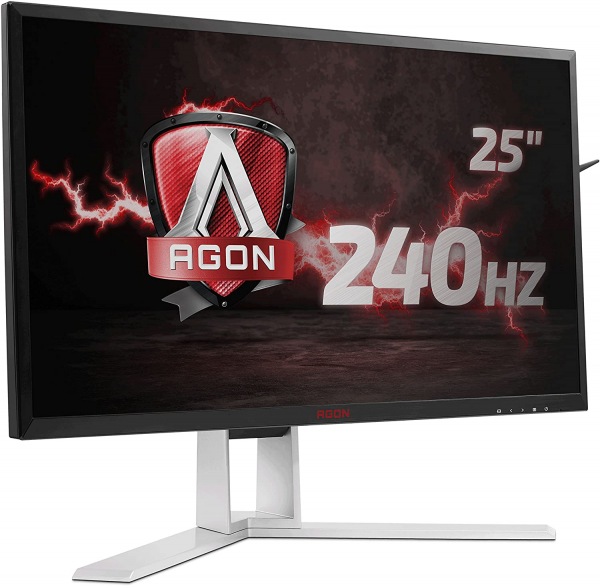AOC
AOC Agon AG251FZ: a 25-inch 240 Hz monitor FreeSync compatible
Aprox. 372€
See specificationsWith the Agon AG251FZ, AOC wants to please players by offering them a monitor capable - on paper - of displaying 240 images per second.
Positive points
FreeSync compatibility.
Reactivity of the slab.
240 Hz native frequency.
Ergonomics.
Full connectivity.
Bad points
Reduced viewing angles.
No backlight scanning (ULMB).
Our review
Presentation
Like the BenQ Zowie XL2540, the AOC Agon AG251FZ operates a 25-inch Full HD TN panel (1920 x 1080 px) supporting a refresh rate of 240 Hz. It stands out from the BenQ model by its FreeSync compatibility which avoids the problems inherent in vertical synchronization, such as tearing of the image and micro-slowdowns. This monitor offers all the small refinements of monitors for AOC players, such as a helmet holder or a remote control.
The AOC Agon AG251FZ is sold for around € 500, a little cheaper than the BenQ Zowie XL2540, the latter being displayed around € 540.
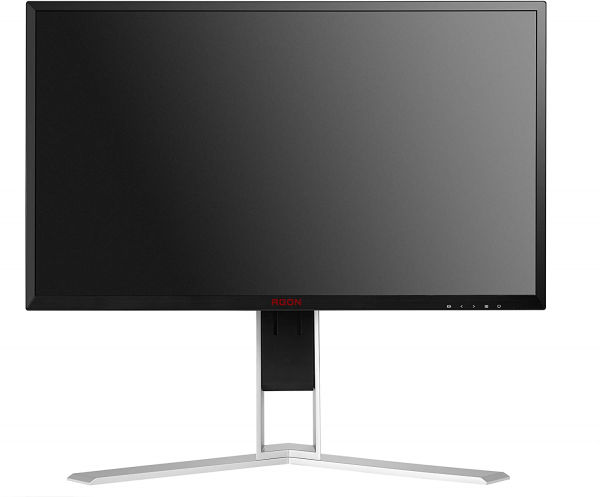
Ergonomics
The design of the AG251FZ is inspired by that of the other monitors in the Agon range. We therefore find a black frame with a few touches of red and above all a very sober aluminum base - especially for a gaming model. The TN panel has a mat treatment which eliminates almost all of the reflections.
The rear is much less sober than the front. Red is omnipresent and sets the tone. We are in the presence of a product that targets players. Always behind, a removable lug allows to hang a helmet.
The stand ensures good stability of the monitor and also allows rotation of ± 20 °. The amplitude of rotation is quite limited on this model.
The monitor is adjustable in height by 13 cm and in inclination from -3.5 ° to + 21.5 °. The pivot also allows the transition to portrait orientation, also used to access the connectors more quickly. The handle at the top of the stand makes it easier to move the 6.5 kg of the monitor.
The connectivity is comprehensive and consists of a DVI input, a VGA input, a DisplayPort input, two HDMI inputs, two inputs and two mini-jack audio outputs, a mini-USB port for connecting the wired remote control and four USB 3.0 ports. It also has two 3-watt speakers sufficient for watching videos on YouTube, but it does not replace a dedicated speaker kit. Note that the power is transferred to an external box.
There are two ways to access the monitor settings: using the buttons at the base of the panel or using the wired remote control. On paper, the remote control is a good idea. In practice, it is ultimately more complicated to use than the buttons on the screen. The arrangement of the buttons is excruciating and errors in handling are frequent. The only benefit of the remote control is the quick access to three game presets. The interface is also very basic and far behind what the competition offers, especially at Acer and Asus.
With a blank set at 150 cd / m² on our test pattern, the AOC Agon AG251FZ consumes 16 watts, ie a relative consumption of 93 W / m². A figure in line with the average consumption of the monitors tested (100 W / m²). At a minimum, the monitor consumes 13 watts (62 cd / m²) and a maximum of 24 watts (381 cd / m²).
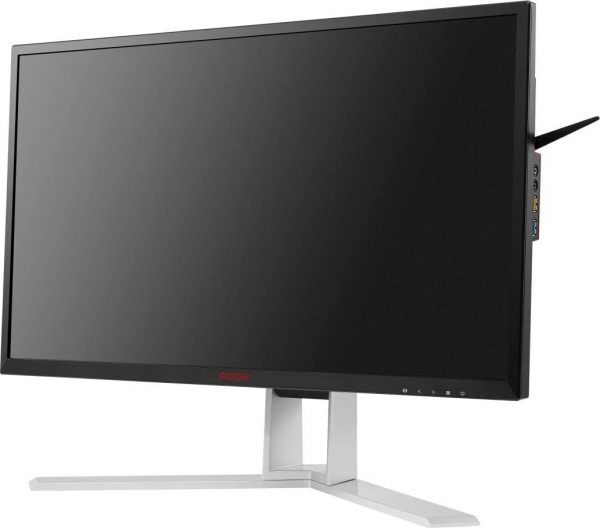
Colors and contrast
Default: average temperature at 6780 K
Default: gamma curve at 1.6
Default: Average Delta E at 6.8
By default, the Agon AG251FZ is very poorly calibrated. The gamma curve literally plunges and the average of 1.6 results in overexposed gray levels across the entire spectrum. With an average Delta E of 6.8, the colors are not faithful. Only the temperature catches up a little with the overall result, with a fairly stable curve and an average (6,780 K) close to the 6,500 K reference.
Manual adjustment: average temperature at 6740 K
Manual adjustment: gamma curve at 2.0
Manual setting: Average Delta E at 3.2
Fortunately, a little twist in the settings helps to correct the situation a little. We lowered the brightness to 30 in order to obtain a white calibrated at 150 cd / m². We then set the gamma to 3 to move the curve up. In the end, the temperature curve is identical while that of the gamma goes up a little. It is still diving, but the average is now 2.0 (closer to the benchmark 2.2). Light grays are not as overexposed as dark grays. The colors are almost faithful - delta E measured at 3.2, knowing that it is difficult to detect a drift below a delta E of 3 -, even if the red, yellow and green are a little capricious.
Default: average temperature at 6480 K
Default: gamma curve at 2.2
Default: Delta E medium at 2.0
Starting from the previous settings, we calibrated the screen using a calibration probe and suitable software. This makes it possible to smooth the temperature and gamma curves perfectly, which are found on the reference values. The colors are also more faithful, with a Delta E of only 2; however, red, green and yellow still show a fairly large drift.
Unsurprisingly for a monitor equipped with a TN panel, the contrast is very low. We measured it at only 670: 1, less than that of the BenQ Zowie XL2540 (840: 1). Blacks therefore appear gray. In comparison, the best models manage to exceed 4000: 1, like the Eizo Foris FG2421 or the Philips BDM4037UW.
The average difference in white is only 11% over the entire 25-inch panel, a fairly average value for a screen of only 25 inches. TN technology requires, the viewing angles are very reduced. Even from the front, we can observe a gradient from top to bottom on a uniform background.
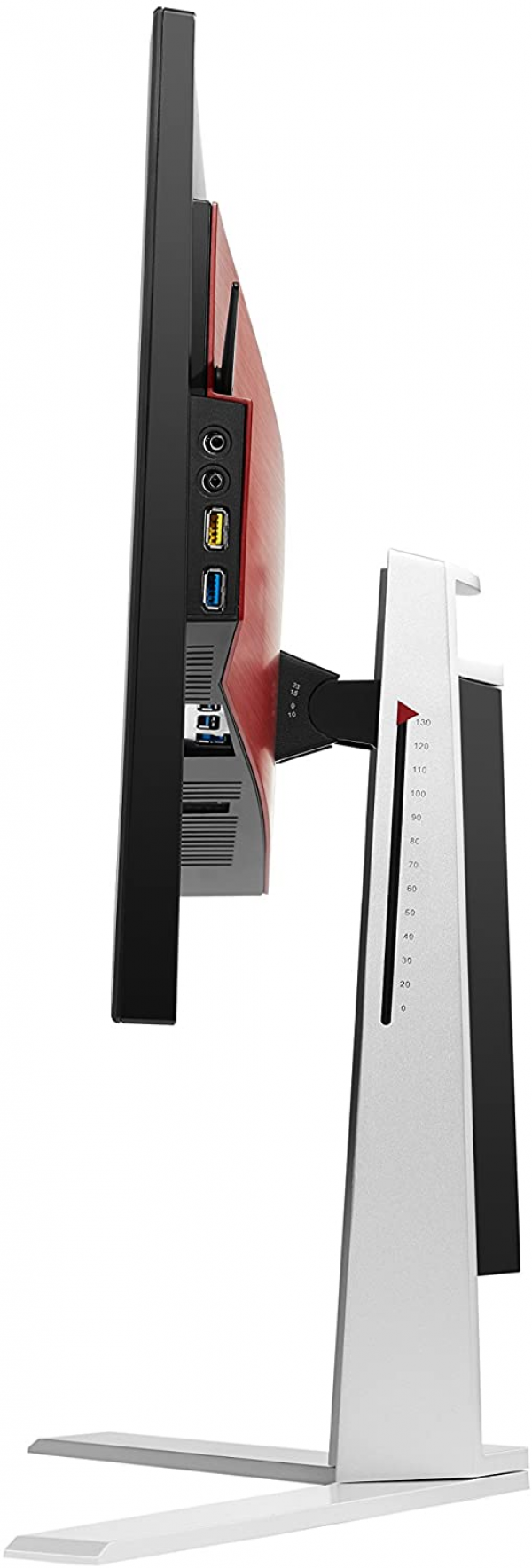
Reactivity
The AOC Agon AG251FZ does not use Pulse Width Modulation (PWM) to vary its brightness. This helps prevent flickering from the dim light that causes headaches and eye strain in some people. So there is no problem with this monitor.
This monitor manages FreeSync between 48 and 240 Hz and it therefore works optimally when the graphics card sends between 48 and 240 images per second. In this case, the fluidity is there and the image does not suffer from tearing problems or jerks (micro-stuttering). In the absence of ULM (Ultra Low Motion Blur) mode, it is not possible to improve the sharpness of moving objects by scanning the backlight.
Please note, we had to use the DisplayPort cable supplied with the monitor to reach the frequency of 240 Hz. It was blocked at 144 Hz with our usual DisplayPort cable.
The TN panel is very reactive (average remanence time of 5 ms), but not faster than that of the BenQ Zowie XL2540 flashed at 3.5 ms. By default, the overdrive, called here Superintensive (sic), is disabled. Setting it to "medium" improves the response time while limiting the ghosting effect. Changing to the "strong" setting results in a rather annoying reverse ghosting phenomenon. With a response time of 5 ms, the pixels cannot change state more than 200 times per second and the monitor cannot therefore display the promised 240 frames per second.
Finally, the delay in display measured at 14.8 ms makes the difference between the image generated by the graphics card and that displayed on the screen almost imperceptible. This remains higher than the 10 ms of other monitors, but it is also the case of the Zowie XL2540.
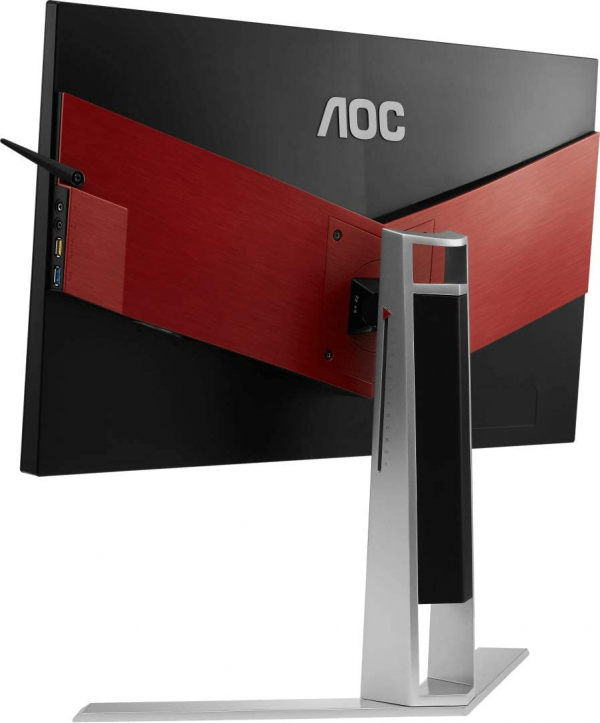
Conclusion
The AOC Agon AG251FZ is a good monitor for games. The 240 Hz frequency combined with good responsiveness and FreeSync compatibility should suit most players. With the exception of the OSD, the ergonomics are flawless and the connectivity is exhaustive. Unfortunately, it doesn't get any better than the BenQ Zowie XL2540, and above all, it loses a star because of its very low contrast.
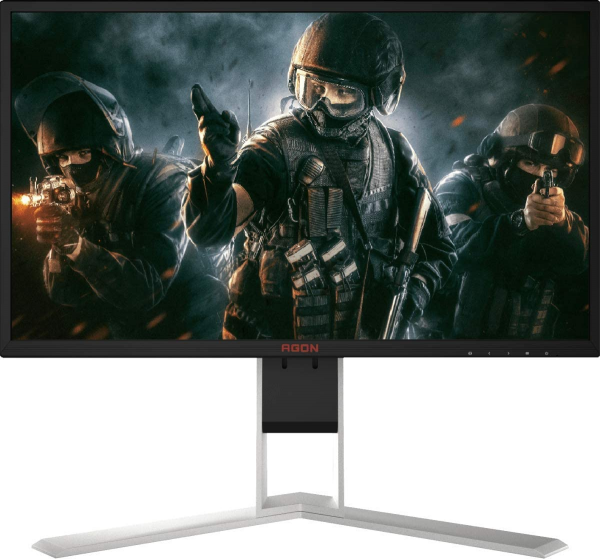
Specifications

